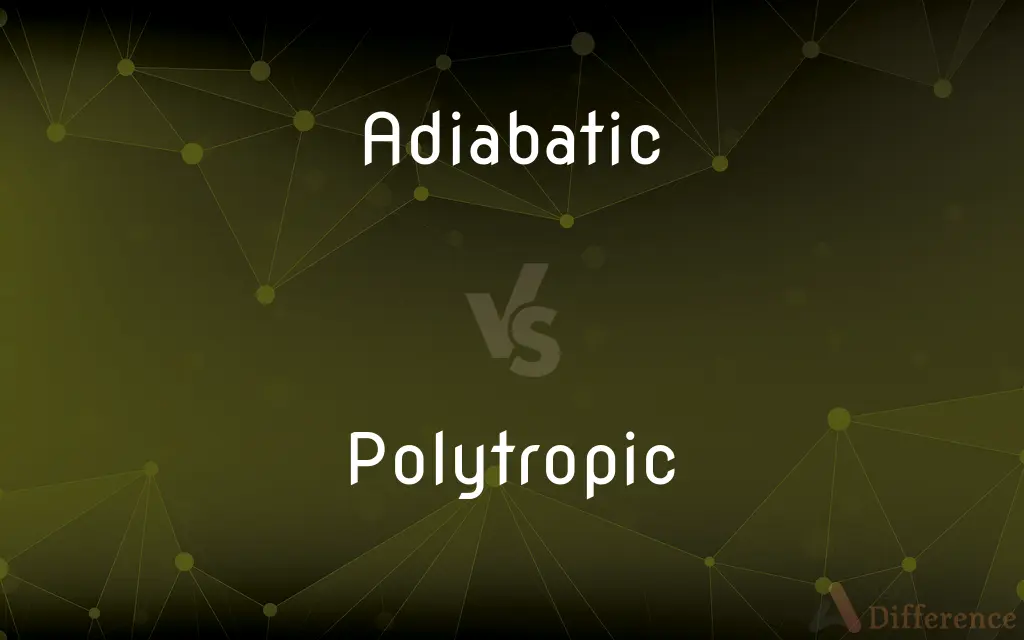Adiabatic vs. Polytropic — What's the Difference?
By Urooj Arif & Maham Liaqat — Updated on March 20, 2024
Adiabatic processes involve no heat exchange, focusing on thermodynamics, while polytropic processes allow heat exchange under specific conditions.

Difference Between Adiabatic and Polytropic
Table of Contents
ADVERTISEMENT
Key Differences
Adiabatic processes are characterized by the absence of heat exchange between a system and its surroundings, playing a crucial role in thermodynamic studies and applications such as gas compression and expansion in engines. Polytropic processes, on the other hand, involve heat exchange but under a specific condition where the heat transfer is related to the work done and pressure-volume changes through a constant exponent.
In adiabatic processes, the focus is on how a system's internal energy changes due to work done on or by the system without heat transfer, which leads to temperature changes within the system. Polytropic processes are more general, covering a range of thermodynamic processes including adiabatic (as a special case), isothermal, and isobaric processes, depending on the value of the polytropic index.
The adiabatic condition is idealized and often used as an approximation in fast processes where heat transfer is minimal or negligible, such as in rapid piston movements within an engine cylinder. Polytropic processes are more versatile, applying to various real-world scenarios where both pressure and temperature of a system change, and heat transfer occurs, such as in refrigeration cycles and natural atmospheric processes.
The thermodynamic equations governing adiabatic and polytropic processes differ, with adiabatic processes described by the equation PVγ = constant, where γ is the heat capacity ratio. Polytropic processes are governed by the equation PVn = constant, where n is the polytropic index, which determines the nature of the process.
Both adiabatic and polytropic processes are fundamental in understanding how energy is transformed and conserved within thermodynamic systems, with adiabatic processes highlighting the conservation of energy in isolated systems, and polytropic processes offering a broader view of energy transformations involving heat exchange.
ADVERTISEMENT
Comparison Chart
Heat Exchange
None
Occurs under specific conditions
Key Characteristic
No heat transfer
Heat transfer related to work done
Idealization
Often idealized for fast processes
More general, applicable to various processes
Thermodynamic Equation
PVγ = constant
PVn = constant
Application Example
Gas compression in engines
Refrigeration cycles, atmospheric processes
Compare with Definitions
Adiabatic
No heat is exchanged with the surroundings.
In an adiabatic compression, the gas heats up as it is compressed.
Polytropic
Covers a wide range of thermodynamic processes.
Polytropic processes can model various real-world thermodynamic scenarios.
Adiabatic
Ideal for modeling rapid processes where heat transfer is minimal.
Adiabatic conditions apply to the quick expansion of gas in a cylinder.
Polytropic
The value of n determines the process type.
A polytropic index of 1 corresponds to an isothermal process.
Adiabatic
Focuses on internal energy changes due to work.
Adiabatic cooling occurs when air rises and expands in the atmosphere.
Polytropic
Heat transfer is related to the work done on or by the system.
In polytropic compression, the gas temperature changes due to work done and heat exchange.
Adiabatic
Used in idealizing processes in engines and turbines.
Jet engines are often analyzed under adiabatic assumptions for simplicity.
Polytropic
Applicable to refrigeration and atmospheric science.
The polytropic approach is used to describe changes in the Earth's atmosphere.
Adiabatic
Governed by the conservation of energy.
The adiabatic process is a cornerstone in understanding thermodynamic cycles.
Polytropic
Provides a more generalized framework for analyzing processes.
The polytropic equation allows for a broad analysis of gas behavior under varying conditions.
Adiabatic
Of, relating to, or being a reversible thermodynamic process that occurs without gain or loss of heat and without a change in entropy.
Polytropic
(physics) of any change in the thermodynamic properties of a gas in which its specific heat remains constant
Adiabatic
That occurs without gain or loss of heat (and thus with no change in entropy, in the quasistatic approximation).
Polytropic
(maths) many-valued
Adiabatic
That involves the slow change of the Hamiltonian of a system from its initial value to a final value.
Adiabatic
An adiabatic curve or graph
Adiabatic
Not giving out or receiving heat.
Adiabatic
Occurring without loss or gain of heat;
Adiabatic expansion
Common Curiosities
Is the polytropic index always the same?
No, the polytropic index n varies depending on the specific thermodynamic process.
Are all adiabatic processes also polytropic?
Yes, adiabatic processes can be considered a special case of polytropic processes where n=γ.
Why is the adiabatic assumption useful in thermodynamics?
It simplifies the analysis of thermodynamic systems by eliminating the complex variable of heat exchange.
Can the polytropic index be negative?
Theoretically, yes, but it would represent an unconventional process in practical thermodynamics.
Can polytropic processes be used to model any thermodynamic system?
Polytropic processes are versatile but may not perfectly model all systems due to simplifications and assumptions.
How do engineers use these concepts in practice?
Engineers use adiabatic and polytropic models to design and analyze systems like engines, turbines, and refrigeration units for efficiency and performance.
How does the polytropic model benefit climate science?
It helps in modeling and predicting atmospheric processes, contributing to a better understanding of climate dynamics.
What role do adiabatic processes play in the performance of refrigeration cycles?
Adiabatic processes are idealized in certain stages of the refrigeration cycle, such as in the compression of the refrigerant.
Are there any limitations to using the adiabatic assumption in engine design?
Yes, real engines involve some heat loss, so the adiabatic assumption can lead to overly optimistic predictions of efficiency.
How do adiabatic and polytropic processes impact renewable energy technologies?
Understanding these processes aids in the design of more efficient renewable energy systems, such as wind turbines and solar thermal collectors.
Can an adiabatic process occur naturally?
Yes, rapid processes like adiabatic cooling in rising air masses are natural examples.
How does the polytropic process relate to everyday weather phenomena?
Polytropic processes can describe temperature and pressure changes in the atmosphere, influencing weather patterns.
Are adiabatic processes more efficient than polytropic ones?
Efficiency depends on the context; adiabatic processes are idealized and can be more efficient under certain conditions, but polytropic processes provide a more realistic view of energy transformations.
Can the concepts of adiabatic and polytropic processes be applied to liquid systems?
While typically applied to gases, these concepts can be adapted to describe certain behaviors in liquids under specific conditions.
Share Your Discovery

Previous Comparison
Partnership vs. Company
Next Comparison
Duct vs. GlandAuthor Spotlight
Written by
Urooj ArifUrooj is a skilled content writer at Ask Difference, known for her exceptional ability to simplify complex topics into engaging and informative content. With a passion for research and a flair for clear, concise writing, she consistently delivers articles that resonate with our diverse audience.
Co-written by
Maham Liaqat














































